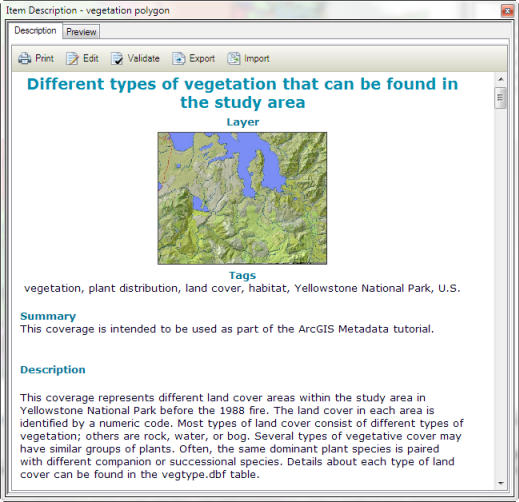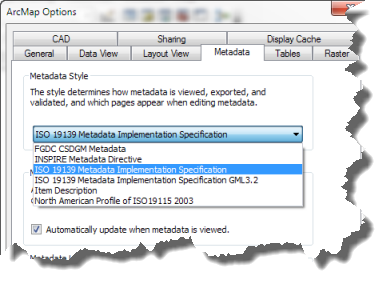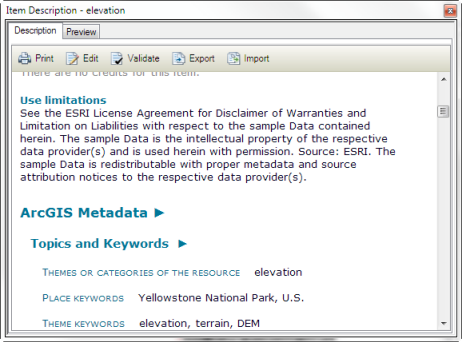Information that describes items in ArcGIS is called metadata. When care is taken to provide good descriptions, you can find appropriate items with a search and evaluate which of the items in your search results is the correct one to use.
In an item's metadata you can record whatever information is important for your organization to know about that item. This might include information about how accurate and recent the item is, restrictions associated with using and sharing the item, important processes in its life cycle such as generalizing features, and so on.
You view and edit an item's metadata in the Description tab, either in ArcCatalog or by opening the Item Description window from other ArcGIS for Desktop applications.

A metadata style configures ArcGIS to create the metadata you want. Choosing a metadata style is like applying a filter to an item's metadata. The style controls how you view the metadata and also the pages that appear for editing metadata in the Description tab. A metadata style may be designed to support a metadata standard or profile. If so, the style will determine how metadata is exported and validated for that standard or profile.
The default Item Description metadata style lets you see and edit a simple set of metadata properties for an item. Only one page of information is available when editing metadata with this style. This style is designed to facilitate providing information that is used by ArcGIS; it is indexed and available for searching and can be published with the item to ArcGIS Online. The Item Description metadata style is straightforward and effective, suitable for anyone who doesn't need to adhere to specific metadata standards.
ArcGIS offers several different metadata styles. If you want to view more information about the item or describe it in more detail than you can with the default Item Description style, choose a different metadata style.

All of the other metadata styles provided with ArcGIS let you view an item's complete metadata. When you click the Edit button you'll see many pages in the Description tab that let you type detailed information.

These metadata styles let you manage metadata appropriately for different standards or profiles, including the Content Standard for Digital Geospatial Metadata (CSDGM) created by the Federal Geographic Data Committee (FGDC), ISO standard 19139 Geographic information — Metadata — XML schema implementation, the North American Profile of ISO 19115:2003 – Geographic information – Metadata (NAP), and the European INSPIRE Metadata Directive. Some of these styles will have extra pages in the editor's table of contents, or a common page will work differently to let you provide content specific to that style. The metadata style also knows how to export content provided in the Description tab to a stand-alone XML file that is formatted correctly for a standard or profile, and how to validate those files using the appropriate XML schema. You may want to publish the exported XML file to a metadata catalog such as the European INSPIRE geoportal or the United States GeoPlatform.gov. If you must create metadata that complies with a specific metadata standard or profile, be sure to choose the appropriate metadata style.
After creating, editing, validating, and exporting metadata for a few items, you'll start to look for ways to streamline your workflow. You can create template metadata documents that contain information common to many items. Import the metadata template before adding details that are specific to that one item. Aside from editing, all metadata tasks can be accomplished using geoprocessing tools that are available in the Conversion toolbox. You can import a metadata template, update contact information, and so on, for many items at once by running a geoprocessing tool or model in batch mode or creating an appropriate Python script. Other scripts can be automated, for example, to periodically export metadata for many items so updated information can be published to a metadata catalog.
The metadata editor and buttons in the Description tab, the buttons on the Metadata toolbar in ArcCatalog, and most of the metadata geoprocessing tools are designed to work with information stored in the new ArcGIS metadata format. If you have metadata created with ArcGIS Desktop 9.3.1 or the FGDC metadata editor add-in, or a stand-alone XML file containing metadata stored in a standard-compliant format, you can view that content in the current version of ArcGIS for Desktop, but it is read-only. Existing content must be upgraded to the new format, or standard-compliant XML files must be imported to ArcGIS before you can edit content and use the buttons in the Description tab.
If you created metadata using the FGDC metadata editor in ArcGIS Desktop 9.3.1 or the FGDC metadata editor add-in, this content is visible under the FGDC Metadata (read-only) heading in the Description tab. You can export and validate this content using the USGS MP Metadata Translator tool.